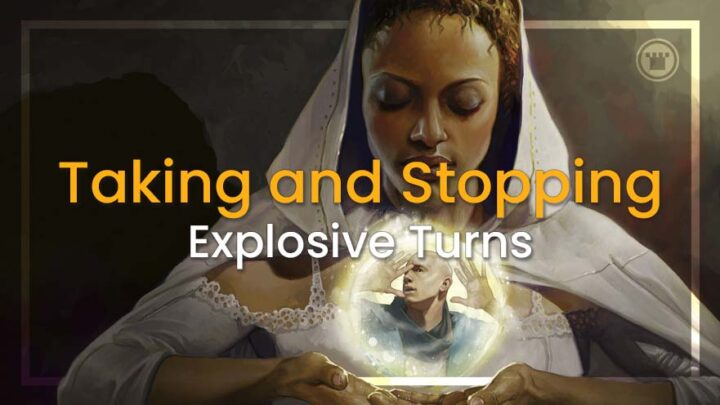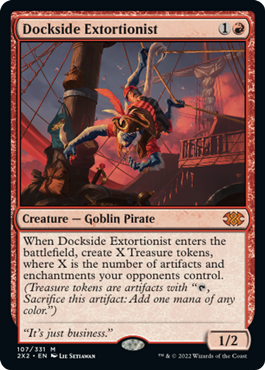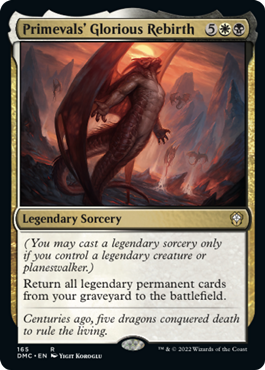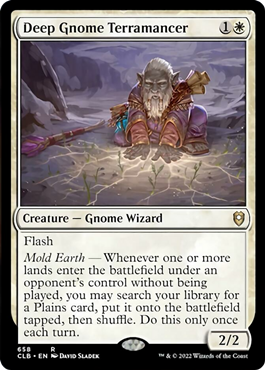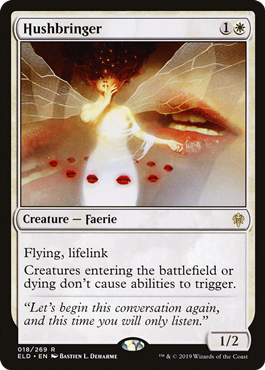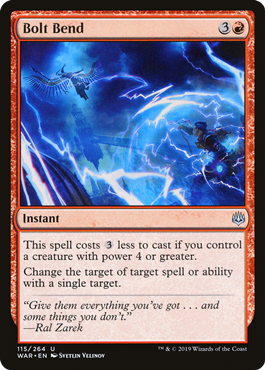One of the sure fire ways to win a game of Commander is to take explosive turns. Kristen is here this week to refocus your deckbuilding on either taking or stopping explosive turns.
Among the easiest and most stylish ways to win a game of Commander, taking an explosive turn is something all players strive for and enjoy. It’s thrilling to see your deck pop off, and sometimes even more thrilling to watch an opponent’s deck do the same — especially if you aren’t super familiar with their strategy.
Setting up an explosive turn is often easier said than done, though, and I guess I should start by defining an “explosive turn” so everyone is on the same page.
What is an Explosive Turn?
An explosive turn is one in which you accomplish multiple game actions to “turn the corner,” or even try to win. Turning the corner is when you pivot from being behind or at parity to getting ahead and/or winning.
I won’t go too deep on Quadrant Theory here, as I already have an article on it. Suffice to say, taking explosive turns and turning the corner go hand in hand.
Explosive turns usually happen when you generate way more mana and/or card advantage than the going rate, and it’s usually accomplished by utilizing specific combos or synergies — or just by casting one, big, splashy sorcery.
Hallmark cards of this style are your Dockside Extortionists and your Mana Geysers for making mana; or your Living Death or Primevals Glorious Rebirth when it comes to repopulating the board.
This turn could also be lots of little spells chained together with a Dualcaster Mage or Bonus Round thrown in. Equally, it could be cheating on equip costs and giving your Commander haste to get in some damage before using Fling and throwing them at another player.
These kinds of “wombo-combo” turns are thrilling to experience, and we often sit curating our hand, waiting for the perfect moment to strike.
Taking Explosive Turns…
Earlier this year, I wrote an article lamenting that White’s last major hurdle in Commander was its struggle to take explosive turns. While it does have cards that help you turn the corner (like Akroma’s Will) it lacks mana efficient ways to catch up or leapfrog — especially ways that don’t require an invested board.
Since then, we’ve seen some cards printed that seek to address this issue. Ascend from Avernus, Deep Gnome Terramancer, Archivist of Oghma; they all help white recover or keep gas in the tank. I’m hopeful this trend continues and that my previous article falls out of relevance.
Now, while white may be the main color that struggles to take explosive turns in Commander, that issue isn’t exclusive to white. It’s something all players can struggle with. When players don’t bake the ability to have big turns into their deck while building it, they can find themselves unable to catch up or otherwise affect a game.
While this style of deckbuilding is relatively OK if you’re playing lower power, even modern precons can have some pretty big turns. Today’s card design is splashy and powerful, and the greater the quantity of “new wave” cards in a deck, the more explosive it is likely to be.
Commander has sped up, but the speed creep mostly revolves around how many resources it takes to generate further resources; less input for the same (or more) output. Pack your deck with the kinds of cards that require a low investment for a high return.
…Or Stopping Them
The alternative — if you aren’t trying to take explosive turns — is to stop others from capitalizing on them. Maybe you don’t own the right cards to make your deck explosive, or maybe you’re playing a strategy that finds it hard to be explosive. In that case? Put up some road blocks.
As I’ve said before, not everything that slows the game down is stax, so you should evaluate your list to see what fits in. Are you relatively low on enter-the-battlefield effects? Play Hushbringer. Are you also playing equipment? Well, damn — Hushbringer got even better. By evaluating the strengths and weaknesses of your build, you can figure out what symmetrical effects you can afford to run alongside the asymmetrical kind.
The key to playing this kind of interaction is by making sure you also have win conditions so you don’t stretch the game out too long. Another way of stopping explosive turns is to be surgical with removal, and pack plenty.
Don’t be afraid of kneecapping a deck that wins when it has enough mana by destroying the early game rocks. Likewise, back-to-back creature wraths can really run opponents out of resources, particularly if they aren’t sure if there’s another one on the way.
While there has been a move toward going interaction-light — spurned in part by content creators, by speed/power creep and by webcam play — you really need to have enough answers if you’re not part of the race.
The Best of Both Worlds
The best decks are those that combine speed bumps for opponents, plentiful interaction and a strong game plan with the ability to take explosive turns.
There are many articles online about how to build good decks, and many decklists. I won’t go fully into that today, as this isn’t the time or the place. However, if I could make one crucial suggestion, I’d turn to that old Limited adage: play more two-drops.
Now, I don’t mean literally play more two drops exactly. Rather, play more low drop creatures that can have an effect on the game — whether through EtBs or static abilities — that can also act as blockers to impede incoming damage.
Attack and damage triggers are huge these days, and just as I covered when I asked “Does going last in EDH suck?” getting caught with your pants down with no blockers just means you’re going to be attacked a lot more than even the players who are the threat.
Alongside those cheap creatures, play more cheap interaction — especially if it can also punish opponents’ plays by leaving you in a better place. The basic premise of this is to look at reactive protection, such as Heroic Intervention, and take it further.
Play Bolt Bend to punish someone else. Play Burnt Offering to get a bunch of mana in the face of a board wipe, which you can use to cast an Instant or activate abilities. Always leave yourself with a back door and a plan B, and you’ll reap the rewards.

Kristen is Card Kingdom’s Head Writer and a member of the Commander Format Panel. Formerly a competitive Pokémon TCG grinder, she has been playing Magic since Shadows Over Innistrad, which in her opinion, was a great set to start with. When she’s not taking names with Equipment and Aggro strategies in Commander, she loves to play any form of Limited.

